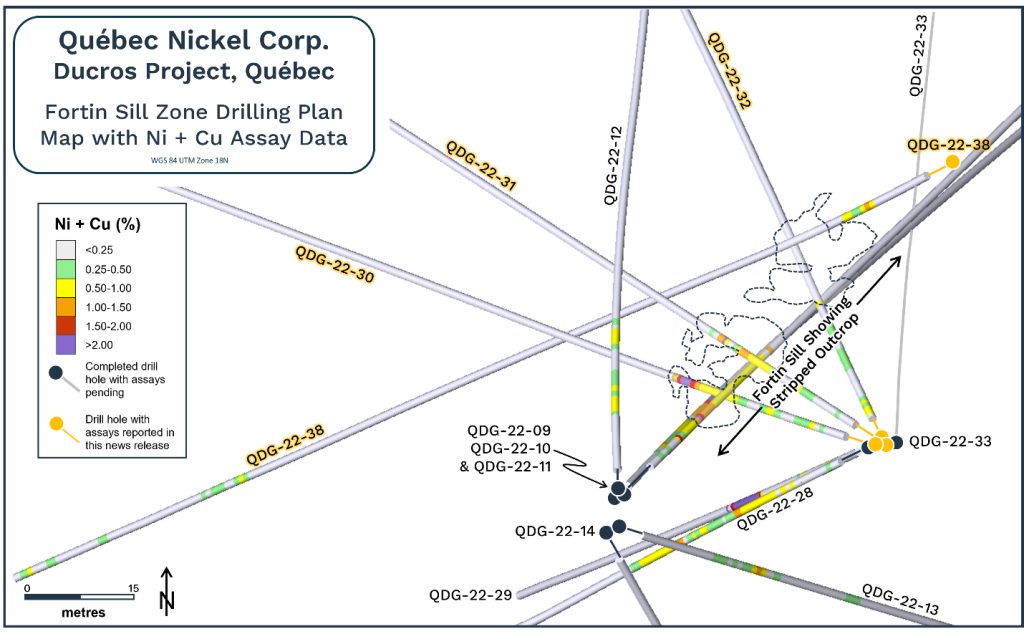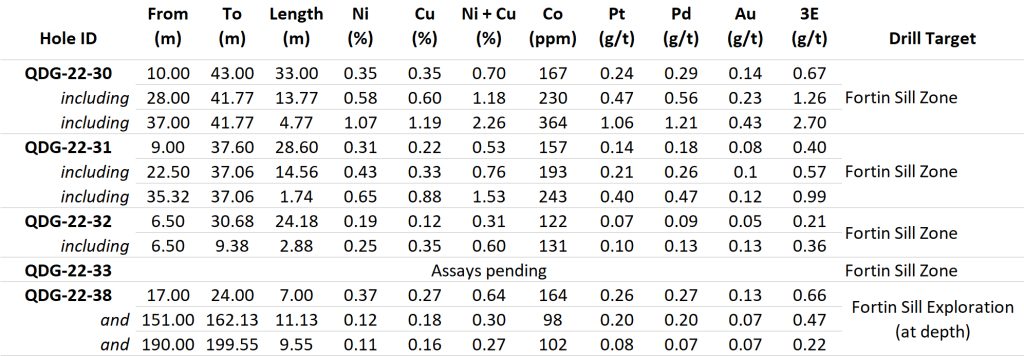
Québec Nickel Reports New High-grade Assay Results From Fortin Sill Zone Drilling Including 1.07% Ni, 1.19% Cu, 364 ppm Co, 2.70 g/t Pt-Pd-Au Over 4.77 Metres
The inaugural 2022 drilling program at the Ducros property is successfully completed and plans are in progress to launch winter work programs including up to 20,000 metres of new drilling in 2023
Québec Nickel Corp. (CSE: QNI) (FSE: 7lB) (OTCQB: QNICF) is pleased to report additional assay results from drilling completed at its Ducros Ni-Cu-Co-PGE-Au Project, 80 kilometres northeast of Val-d’Or, Québec. Assay results are reported here for four holes completed at the Fortin Sill Zone and demonstrate the zone extends from the mineralized surface outcrop to the southeast. In addition, the assay results also highlight the potential for discovery of additional Fortin Sill Zone-like bodies at depth.
Drilling Highlights:
- Magmatic Ni-Cu-PGE sulphides encountered in three new holes collared to the southeast of the Fortin Sill Zone discovery outcrop.
- Hole QDG-22-30 cored through 0.58% Ni, 0.60% Cu, 230 ppm Co and 1.26 g/t Pt-Pd-Au over 13.77 metres, including 1.07% Ni, 1.19% Cu, 364 ppm Co and 2.70 g/t Pt-Pd-Au over 4.77 metres.
- Hole QDG-22-31 returned a 14.56 metre interval containing 0.43% Ni, 0.33% Cu, 193 ppm Co and 0.57 g/t Pt-Pd-Au and includes a higher-grade subinterval assaying 0.65% Ni, 0.88% Cu, 243 ppm Co and 0.99 g/t Pt-Pd-Au over 1.74 metres.
- Highly anomalous results were also returned from hole QDG-22-38 at depth and to the southwest of the Fortin Sill Zone proper and include 0.64% Ni + Cu, 164 ppm Co and 0.66 g/t Pt-Pd-Au over a seven-metre core length.
2022 Ducros Project Drilling Results
Dill holes QDG-22-30 through QDG-22-33 were collared southeast of the Fortin Sill Zone discovery outcrop at the same location as holes QDG-22-28 & QDG-22-29, the results of which were previously reported in Q3 2022 and include an 11.80 metre interval containing 1.44% Ni, 1.49% Cu, 461 ppm Co and 2.79 g/t Pt-Pd-Au in hole QDG-22-29 (see August 30, 2022 News Release). The four holes were directed towards the surface showing (Figure 1), of which three returned long intervals of Ni-Cu-Co-PGE-Au mineralization (see Table 1). Notably, Hole QDG-22-30 cored through a 33.00-metre-long interval averaging 0.35% Ni, 0.35% Cu, 167 ppm Co, and 0.67 g/t Pt-Pd-Au which includes higher-grade subintervals of 0.58% Ni, 0.60% Cu, 230 ppm Co and 1.26 g/t Pt-Pd-Au over 13.77 metres and 1.07% Ni, 1.19% Cu, 364 ppm Co and 2.70 g/t Pt-Pd-Au over 4.77 metres. Results for the fourth hole, QDG-22-33, are still pending.
Assay results are also reported for hole QDG-22-38, which was collared on the northeast side of the Fortin Sill Zone discovery outcrop and drilled towards the southwest under the bedrock exposure. The geology and mineralization encountered in this hole are summarized in the Company’s October 19, 2022 News Release and summary assay results are provided below in Table 1. The occurrence of strongly anomalous Ni-Cu-Co-PGE-Au mineralization well below the Fortin Sill Zone within QDG-22-38 highlights the potential of discovering additional Ni-Cu-Co-PGE-Au mineralization at depth and throughout the greater Fortin Sill Zone target area. As discussed in the Company’s October 19, 2022 News Release, a series of holes was completed from an existing drill pad to the southwest of the Fortin Sill Zone to test for the continuity of this deeper mineralization, and assays are pending for these holes.
The Company is also pleased to announce its inaugural 2022 drilling program at the Ducros project has been successfully completed. Just over 21,000 metres were drilled in 91 holes across the Ducros property utilizing up to three drills. A multitude of geophysical and geological targets were drill tested across the property this year. The vast majority of the new data were collected in areas that have had very little or no previous exploration work completed. Core logging and sampling is ongoing and core samples are being delivered to the assay laboratory on a regular basis. To date, approximately 50% of the assay results from submitted and yet to be submitted core samples have been received. It is expected all remaining core samples will be delivered to the assay lab before the end of December.
Updated Exploration Model for the Fortin Sill Zone
An analysis of all the data collected at the Ducros property this year has resulted in a refined geological/exploration model for the Fortin Sill Zone (Figure 2). A review and integration of relevant geophysical data (VTEMTM, drone magnetics, airborne gravity), along with historical and QNI drilling results in addition to recent surface geological mapping indicates the Ni-Cu-Co-PGE-Au mineralization at the Fortin Sill Zone occurs at or near the footwall contact of a large west-southwest-dipping embayment structure within the larger mafic to ultramafic Fortin Sill. The overall Fortin Sill intrusive body is interpreted to span several hundred metres or more in an approximate northwest-southeast trend and is characterized by the occurrence of a large blow-out, or embayment, at the Fortin Sill Zone. The conceptual geologic model is supported by several lines of evidence including:
- Hanging wall and footwall contacts between the Fortin Sill and host country rocks identified during detailed surface geological mapping completed this past summer.
- The observation of large blocks (xenoliths) of country rock basalts and sediments within the Fortin Sill intrusion, as seen in the discovery outcrop, regional mapping and within drill core.
- Identification of a gradation in composition of the host rocks at the Fortin Sill Zone from ultramafic pyroxenitic (PXT) rocks at the footwall side of the embayment, through varitexture gabbronoritic rocks in the centre of the embayment (GBNOR), to more evolved gabbroic rocks (GBRO) at the hanging wall side of the structure.
- The Fortin Sill intrusion and corresponding embayment structure is identifiable within the various geophysical datasets, specifically in the recently collected drone magnetic data as well as within some of the historical datasets.
This refinement in the exploration model is being used to plan the next phase of work at Fortin Sill Zone and will likely include the drill testing of the newly modelled footwall contact along its entire surface, both along strike and at depth.
In addition to the processing of the remaining 2022 drill core, logistical planning is in progress that envisages the completion of up to 20,000 metres of new drilling across the Ducros claims in 2023. While additional drilling and 3D geological modelling will continue at the Fortin Sill Zone, it is expected the bulk of the 2023 drilling program will be focused on exploring the remaining 98% of the Ducros claims, including at the Ducros Ultramafic Sill Complex and Ducros Gabbro targets.
Core Processing & QAQC
Québec Nickel has implemented a quality assurance and quality control (“QAQC”) program for its Ducros Project to ensure best practices for logging, sampling, and analysis of its drill core as well as for the collection and analyses of rock samples. This includes the regular insertion of geochemical blanks, duplicates and multiple Ni-Cu-PGE-Au certified reference material standards (CRMs) into the sample stream.
Drill core is collected by Ducros Project personnel daily from the drill rigs and transported in secured core boxes to QNI’s core logging facilities in Val d’Or. Logging is completed on laptops and data are captured using fit-for-purpose computer software.
Core destined for geochemical analyses is identified and labeled by core logging geologists and is then sawed in half by a diamond blade. One half of the NQ-diameter core sample is placed in a labeled and secured sample bag. The remaining half of the core sample is returned to its core box for archiving. All core samples are transported from QNI’s logging facilities to AGAT Laboratories’ sample preparation facility in Val-d’Or in secured and numbered rice bags by project personnel.
AGAT Laboratories is accredited to the ISO/IEC 17025:2017 and ISO 9001:2015 standards. Analysis for precious metals (gold, platinum, and palladium) is completed by Fire Assay with an ICP-OES finish while analyses for nickel, copper, and 41 other elements are performed using AGAT’s 4 Acid Digest – Metals Package, with an ICP-OES finish.
QUALIFIED PERSON
Gary DeSchutter, M.Sc., P.Geo., Vice-President of Exploration for Québec Nickel Corp., and a Qualified Person as defined under National Instrument 43-101 (“NI 43-101”), has reviewed, and approved the scientific and technical content of this press release.
ABOUT QUEBEC NICKEL CORP.
Québec Nickel Corp. is a mineral exploration company focused on acquiring, exploring, and developing nickel projects in Québec, Canada. The Company has a 100% interest in the Ducros Property, consisting of 280 contiguous mining claims covering 15,147 hectares within the eastern portion of the Abitibi Greenstone Belt in Québec, Canada.
Figure 1. Plan map showing the locations of selected drill holes completed at the Fortin Sill Zone with Ni + Cu assays (%) in relation to the outline of the Fortin Sill discovery outcrop. Drill holes with new assay results reported herein are highlighted in orange i.e. QDG-22-30 through QDG-22-32 and QDG-22-38.
Table 1. Summary assay results for holes QDG-22-30 through QDG-22-32 and QDG-22-38 (1,2,3) 1. Reported assay intervals are sample length weighted. 2. The true width of mineralized intervals is not known due to insufficient information. 3. 3E = Pt+Pd+Au
Figure 2. Plan view sketch map showing a conceptual geological model for the location and emplacement of the Fortin Sill Zone within the larger mafic to ultramafic Fortin intrusion. Shown is the gradational nature of the Fortin Sill Zone host rocks from an ultramafic footwall base (PXT = pyroxenite), through a mafic/ultramafic mid-zone (GBNOR = gabbronorite) to a mafic hanging wall top (GBRO = gabbro).
MORE or "UNCATEGORIZED"
Kuya Silver Confirms High-Grade Silver-Gold Vein Mineralization at Umm-Hadid with Initial Drill Results up to 1483.9 g/t AgEq over 2 Metres
Kuya Silver Corporation (CSE: KUYA) (OTCQB: KUYAF) (FSE: 6MR1) is... READ MORE
First Phosphate Closes Final Tranche of Oversubscribed Private Placement
First Phosphate Corp. (CSE: PHOS) (OTCQX: FRSPF) (FSE: KD0) is... READ MORE
GFG Receives Final Payment from the Sale of its Rattlesnake Hills Gold Project
GFG Resources Inc. (TSX-V: GFG) (OTCQB: GFGSF) announces that i... READ MORE
Goliath Receives $1,730,882 Through Warrant Exercises, Inclusive Of Crescat Capital A Longtime Strategic And Cornerstone Shareholder
Goliath Resources Limited (TSX-V: GOT) (OTCQB: GOTRF) (FSE: B4IF)... READ MORE
Robex Pours First Gold at Kiniéro on Schedule and Budget
Highlights: Gold bar weighing 2.64 kilograms (85 oz) poured in th... READ MORE
















